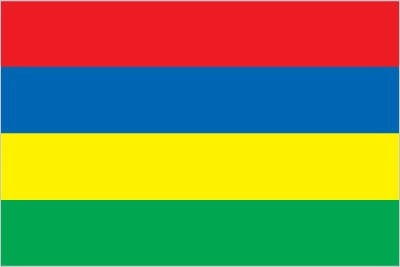
Mauritius
Country Flag Details
four equal horizontal bands of red (top), blue, yellow, and green; red represents self-determination and independence, blue the Indian Ocean surrounding the island, yellow has been interpreted as the new light of independence, golden sunshine, or the bright future, and green can symbolize either agriculture or the lush vegetation of the island
note: while many national flags consist of three – and in some cases five – horizontal bands of color, the flag of Mauritius is the world’s only national flag to consist of four horizontal color bands.
Background
Mauritius was uninhabited until 1638 when the Dutch established a settlement, and first France and then the UK controlled the island. Mauritius gained independence from the UK in 1968 and has remained a stable democracy.
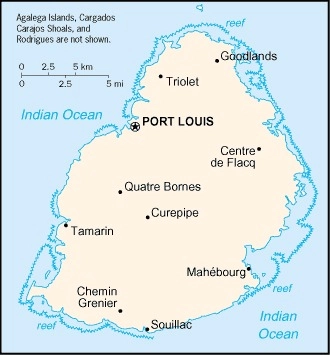
Geography
Area
total : 2,040 sq km
land: 2,030 sq km
water: 10 sq km
Climate
tropical, modified by southeast trade winds; warm, dry winter (May to November); hot, wet, humid summer (November to May)
Natural resources
arable land, fish
People and Society
Population
total: 1,310,504
Ethnic groups
Indo-Mauritian (compose approximately two thirds of the total population), Creole, Sino-Mauritian, Franco-Mauritian
Languages
Creole 86.5%, Bhojpuri 5.3%, French 4.1%, two languages 1.4%, other 2.6% (includes English, one of the two official languages of the National Assembly, which is spoken by less than 1% of the population), unspecified 0.1% (2011 est.)
Religions
Hindu 48.5%, Roman Catholic 26.3%, Muslim 17.3%, other Christian 6.4%, other 0.6%, none 0.7%, unspecified 0.1% (2011 est.)
Population growth rate
0.07% (2024 est.)
Government
Government type
parliamentary republic
Capital name: Port Louis
Executive branch
chief of state: President Dharam GOKHOOL (since 7 December 2024)
head of government: Prime Minister Navin RAMGOOLAM (since 13 November 2024)
Economy
Economic overview
upper middle-income Indian Ocean island economy; diversified portfolio; investing in maritime security; strong tourism sector decimated by COVID-19; expanding in information and financial services; environmentally fragile
Real GDP (purchasing power parity)
$33.532 billion (2023 est.)
$31.35 billion (2022 est.)
$28.793 billion (2021 est.)
Real GDP per capita
$26,600 (2023 est.)
$24,800 (2022 est.)
$22,700 (2021 est.)
Exports
$5.495 billion (2023 est.)
$5.004 billion (2022 est.)
$3.194 billion (2021 est.)
Exports – partners
USA 11%, France 11%, Zimbabwe 10%, South Africa 7%, Zambia 7% (2023)
Exports – commodities
fish, garments, raw sugar, fertilizers, diamonds (2023)
Imports
$8.027 billion (2023 est.)
$8.052 billion (2022 est.)
$6.057 billion (2021 est.)
Imports – partners
China 15%, UAE 11%, India 10%, South Africa 9%, France 6% (2023)
Imports – commodities
refined petroleum, cars, fish, coal, packaged medicine (2023)

Export structure by product group in 2023 (% of total exports) (UNCTAD)
The export structure of a country encompasses the variety, composition, and value of its goods and services traded internationally, offering crucial insights into the nation’s economic vitality, competitiveness, and stage of development. In this context, Mauritius is actively working to diversify its exports by embracing innovative strategies and expanding into high-value industries such as fintech, biotechnology, and renewable energy. This commitment not only enhances its competitive edge in the global market but also positions Mauritius as a key player in the evolving landscape of international trade.

Poverty and vulnerable employment in Mauritius
In 2023, 16 percent of Mauritius’ total employment was identified as vulnerable employment, a category that encompasses jobs characterized by limited security, low wages, and minimal benefits such as health insurance or retirement plans. This primarily includes self-employed individuals without employees, like street vendors and small-scale farmers, along with family members contributing to family businesses or farms without formal compensation. These positions are often informal and precarious, putting workers at risk of financial hardships and exploitation, which can perpetuate cycles of poverty. The repercussions of vulnerable employment extend beyond the individual, impacting families and communities, and fostering instability that is challenging to overcome.
Understanding poverty level significance at $2.15 per day
In 2017, 0.13 percent of Mauritius’ population (1585 people) was identified as living in poverty at an income threshold of $ 2.15 per day, The poverty level at $2.15 per day (measured in 2017 purchasing power parity, or PPP) is a key global benchmark used by the World Bank to define extreme poverty in low-income countries. It indicates:
1. Basic Survival Threshold
• People living below $2.15 per day struggle to afford essential needs such as food, clean water, shelter, healthcare, and education.
2. Economic Underdevelopment
• A high percentage of a country’s population living below this threshold suggests low economic productivity, high unemployment, and weak social safety nets.
3. Inequality and Social Vulnerability
• It reflects deep income inequality and a lack of access to opportunities for upward mobility.
• People in this category are more vulnerable to shocks like food price increases, climate disasters, or health crises.
4. Policy Challenges
• Governments need targeted interventions such as social welfare programs, job creation, and improved access to education and healthcare to reduce poverty.
A country's export structure is a reflection of its level of development and productive capacities
The export structure of a country refers to the composition, diversity, and value of the goods and services it sells to other countries. It provides key insights into the country’s economic health, competitiveness, and level of development. Productive capacities of a country refer to its ability to produce goods and services efficiently and sustainably over time. These capacities are shaped by various factors, including human capital, natural resources, infrastructure, private sector, development, technology & innovation, institutions & governance, financial systems trade & market access.
Here’s what the export structure and productive capacities of a country typically indicate:
- Level of Economic Development
- Developed economies usually export high-value manufactured goods, technology, and services.
- Developing economies often rely on raw materials, agricultural products, or low-value manufactured goods.
- Industrial and Sectoral Strengths
- A strong presence of high-tech or industrial goods (e.g., machinery, electronics) suggests a well-developed manufacturing sector.
- A dominance of commodities (e.g., oil, minerals, agricultural products) indicates reliance on natural resources.
- Export Diversification
- A diverse export base (multiple industries) makes a country’s economy more stable and resilient to global price shocks.
- A concentrated export base (few key products) makes it vulnerable to market fluctuations.
- Trade Partnerships and Dependence
- If exports are heavily dependent on a single country or region, the economy is more exposed to geopolitical and trade risks.
- A wide range of trading partners indicates stronger global integration.
- Competitiveness and Value Addition
- Exporting mainly raw materials (e.g., crude oil instead of refined petroleum) suggests limited industrial processing capacity.
- A high share of finished and high-tech goods suggests strong value addition and competitiveness.
Mauritius-Sanitation
Mauritius- Proportion of population served with at least basic sanitation
In 2022, proportion of population served with at least basic sanitation for Mauritius was 96.0%. Proportion of population served with at least basic sanitation of Mauritius increased from 90.1 % in 2000 to 96.0% in 2022 an absolute change of 5.9 percentage points (pp) between 2000 and 2022.
Mauritius – Proportion of urban population served with at least basic sanitation
In 2022, proportion of urban population served with at least basic sanitation for Mauritius was 95.8 %. Proportion of urban population served with at least basic sanitation of Mauritius increased from 92.3 % in 2000 to 95.8 % in 2022 an absolute change of 3.5 pp between 2000 and 2022.
Mauritius – Proportion of rural population served with at least basic sanitation
In 2022, proportion of rural population served with at least basic sanitation for Mauritius was 95.0 %. Proportion of rural population served with at least basic sanitation of Mauritius increased from 88.5 % in 2000 to 95.0 % in 2022 an absolute change of 6.5 pp between 2000 and 2022.
Mauritius – Proportion of population served with at least basic sanitation: A Global Perspective
The lack of safe sanitation in Mauritius is a pressing public health issue that significantly affects lives, calling for urgent collective action. Each year, preventable deaths highlight the need for improved sanitation access as it is a fundamental human right. In 2022, about 50 thousand people, nearly 4 percent of the population, suffered due to inadequate sanitation, a situation similar to countries like China, and Malaysia. The global average for those without proper sanitation is around 6 percent, emphasizing the necessity for coordinated efforts to enhance access in marginalized communities, particularly in Sub-Saharan Africa.

Mauritius – Proportion of rural population served with at least basic sanitation: A Global Perspective
In 2022 nearly 37000 individuals in rural Mauritius about 5 percent of this population lacked access to basic sanitation facilities, a situation similar to countries like Sri Lanka and Malaysia. Safe sanitation is a fundamental human right that everyone deserves without exception. Let us unite to advocate for this essential right across Sub-Saharan Africa where the need is urgent and the potential for impactful change is vital for the well-being and dignity of every individual affected.
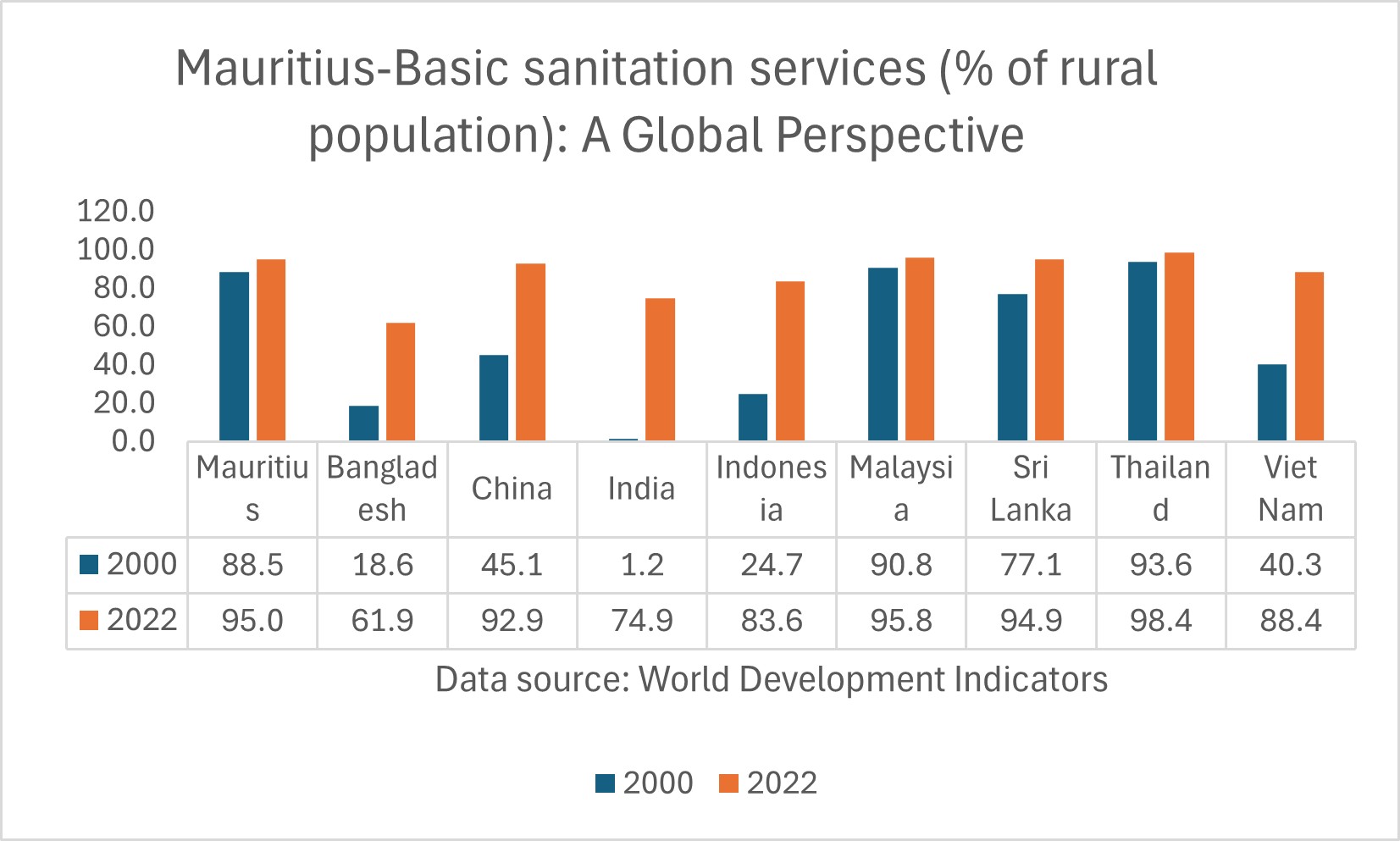
Mauritius-Water Supply
Mauritius – Proportion of total population served with at least basic drinking water
In 2022, proportion of urban population served with at least basic water for Mauritius was 100%. Between 2000 and 2022, the proportion of population served with at least basic drinking water in Mauritius increased from 99.3 % in 2000 to 100% in 2022 an absolute change of 0.7 pp between 2000 and 2022.
Mauritius – Proportion of urban population served with at least basic water
In 2022, proportion of urban population served with at least basic water for Mauritius was 100%. Between 2000 and 2022, the proportion of population served with at least basic drinking water in Mauritius increased from 99.8 % in 2000 to 100% in 2022 an absolute change of 0.2 pp between 2000 and 2022.
Mauritius- Proportion of rural population with at least basic water
In 2022, proportion of rural population served with at least basic water for Mauritius was 100%. Between 2000 and 2022, the proportion of population served with at least basic drinking water in Mauritius increased from 98.9 % in 2000 to 100% in 2022 an absolute change of 1.1 pp between 2000 and 2022.
Mauritius- Proportion of population served with at least basic drinking water: A Global Perspective
Access to safe drinking water is a fundamental human right and essential for survival, demanding urgent action from all sectors of society. In 2022, nearly 1.3 million people in Mauritius, almost the entire population, accessed basic water services, a significant public health achievement that should motivate efforts in Sub-Saharan Africa. Similarly, everyone in Thailand and 98 percent of individuals in Vietnam and Bangladesh had reliable access to safe drinking water in 2022, showcasing attainable benchmarks. This scenario urges us to pursue bold reforms in Sub-Saharan Africa, where many still lack vital resources for improving their quality of life. We must unite to strengthen our commitment to closing this gap and ensure that everyone has access to safe drinking water, reflecting our collective ethical responsibility as a global community.

Mauritius- Proportion of rural population served with at least basic drinking water: A Global Perspective
In 2022, Mauritius achieved a remarkable milestone in Sub-Saharan Africa by providing 100 percent access to safe drinking water for its rural population, reflecting significant progress worthy of attention. This success encourages us to envision transformative change, as evidenced by similar efforts in Thailand, and Bangladesh. While these achievements highlight what is possible, they also reveal the ongoing inequalities that affect many nations in Sub-Saharan Africa, underscoring the urgent need for collective actions and collaborative initiatives to improve living conditions and ensure vital resources reach vulnerable communities across Sub-Saharan Africa.
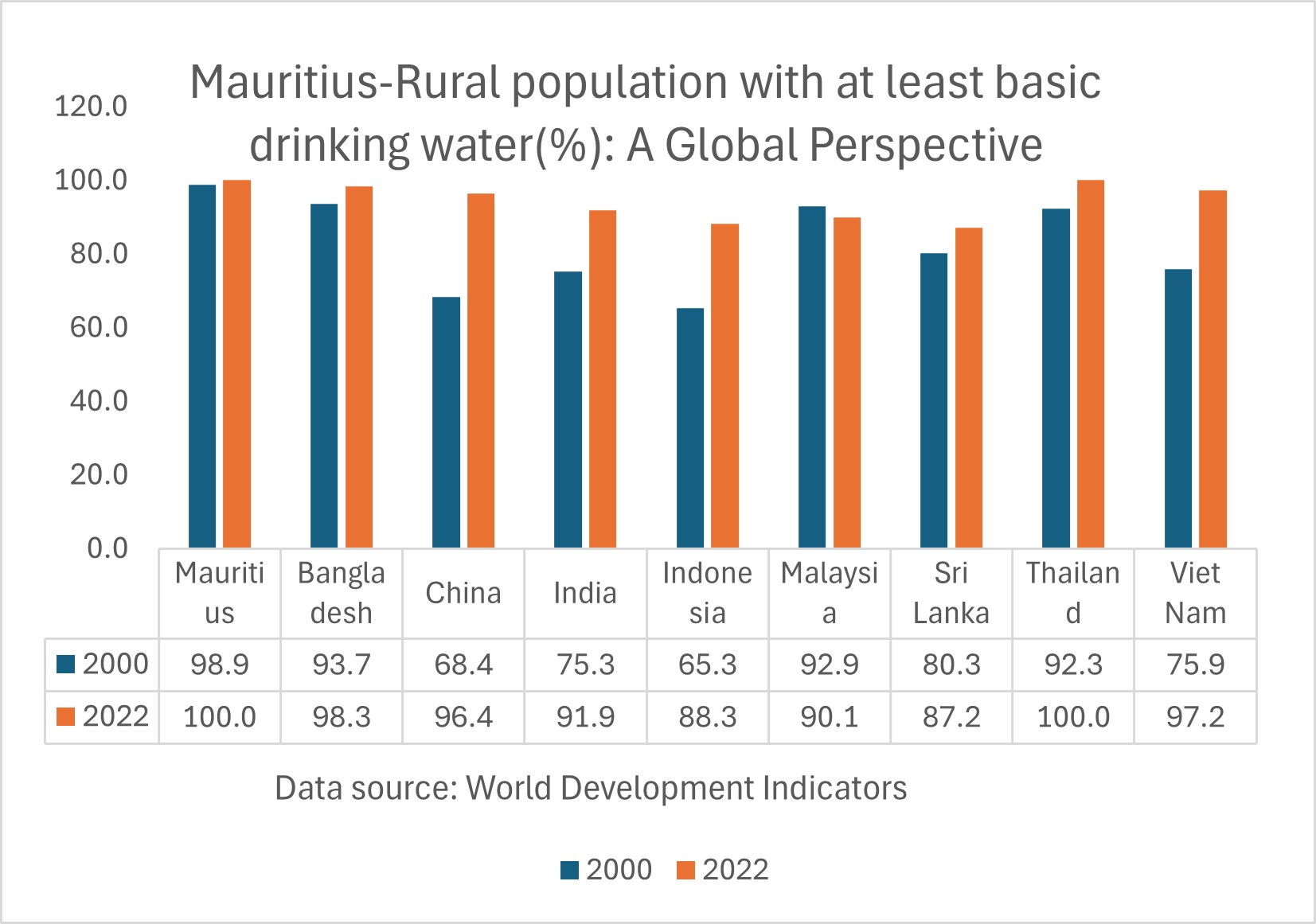
Mauritius-Access to Electricity
Mauritius-Access to electricity (% of population)
In 2022, proportion of population with access to electricity for Mauritius was 100 % in 2022. The proportion of population with access to electricity of Mauritius increased from 99% in 2000 to 100% in 2022, an absolute change of 1 pp between 2000 and 2022.
Mauritius-Access to electricity (% urban population)
In 2022, proportion of urban population with access to electricity for Mauritius was 100%. The proportion of urban population with access to electricity of Mauritius gradually declined from 100% % in 2000 to 99% in 2022, an absolute change of 1 pp between 2000 and 2022.
Mauritius-Access to electricity (% of rural population)
In 2022, proportion of rural population with access to electricity for Mauritius was 100 %. The proportion of rural population with access to electricity of Mauritius increased from 98.3 % in 2020 to 100% in 2022, an absolute change of 1.7 pp between 2000 and 2022.
Mauritius- Proportion of population served with electricity: A Global Perspective
In 2022, Mauritius achieved a remarkable milestone by providing almost its entire population with access to electricity, benefiting over 1.3 million people. This success positions Mauritius alongside countries like Vietnam, Thailand, Sri Lanka, and Malaysia, which have also attained universal electricity access. This progress emphasizes the urgent need for reforms in Sub-Saharan Africa to improve living conditions and address energy access inequalities. The absence of reliable electricity hampers development, public health, education, and economic opportunities vital for enhancing living standards and fostering a sustainable future, particularly for those in many sub-Saharan African nations, who still struggle with basic services and growth opportunities.
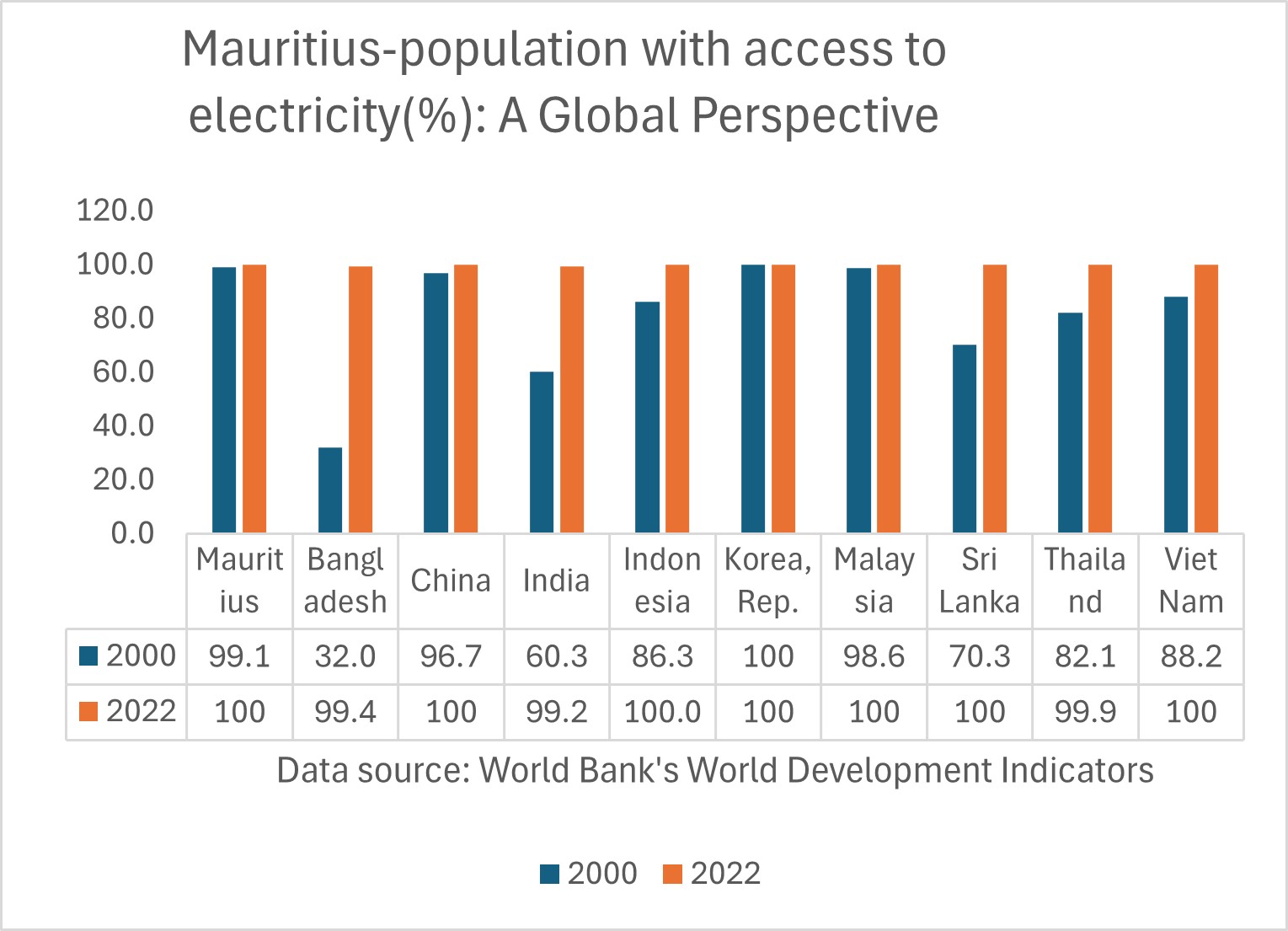
Mauritius- Proportion of rural population served with at least basic drinking water: A Global Perspective
In 2022, Mauritius boasted 100 percent electricity access for its rural population, a remarkable achievement that parallels countries like Vietnam, Thailand, and Sri Lanka, where rural communities also enjoy full electricity availability. India and Bangladesh have made significant strides as well, with approximately 99 percent of their rural populations connected to electricity. These compelling statistics highlight the urgent need for transformative governance reforms throughout Sub-Saharan Africa, aimed at ensuring dependable electricity access for every community, empowering them to thrive and fostering collaboration towards a sustainable and prosperous future for all.
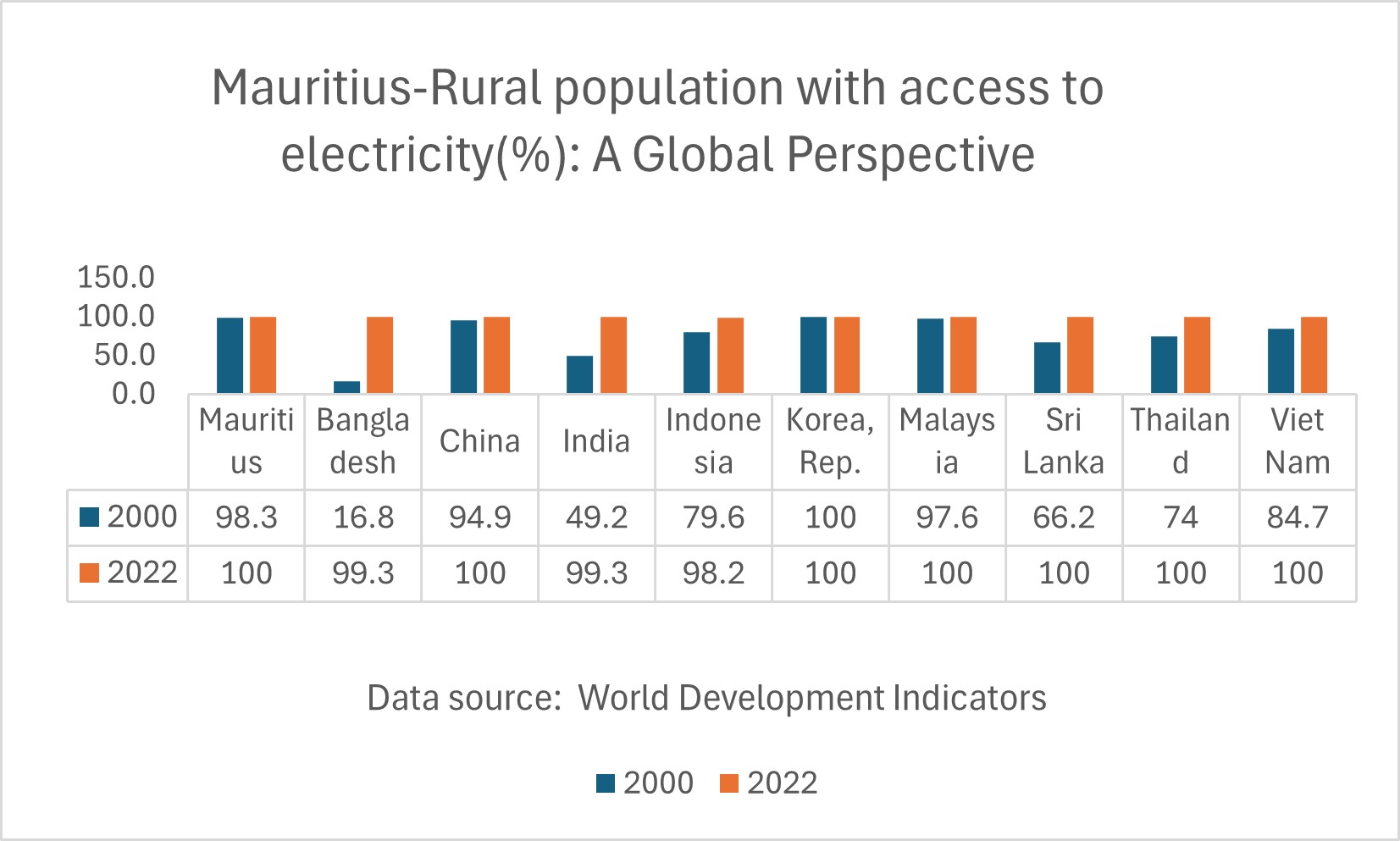
Mauritius: Health outcomes
Mauritius-Life expectancy: A Global Perspective
Mauritius has seen a remarkable rise in life expectancy over the past seven decades, reflecting global trends while highlighting the significant disparities that persist in Sub-Saharan Africa. The global average life expectancy for newborns increased from 47 years in 1950 to 71 years by 2021, yet many Sub-Saharan African nations continue to show minimal progress. In contrast, Mauritius has advanced considerably, with life expectancy growing from 55 years in 1960 to 74 years in 2022, aligning with improvements in certain Asian countries. For example, South Korea’s life expectancy soared from 54 years in 1960 to 83 years in 2022, while the Maldives improved from 39 years in 1960 to 81 years in 2022. The low life expectancy in several Sub-Saharan African nations highlights the urgent challenges they face, including poverty and inadequate healthcare, underscoring the need for compassionate initiatives to create a sustainable and equitable future for these communities.
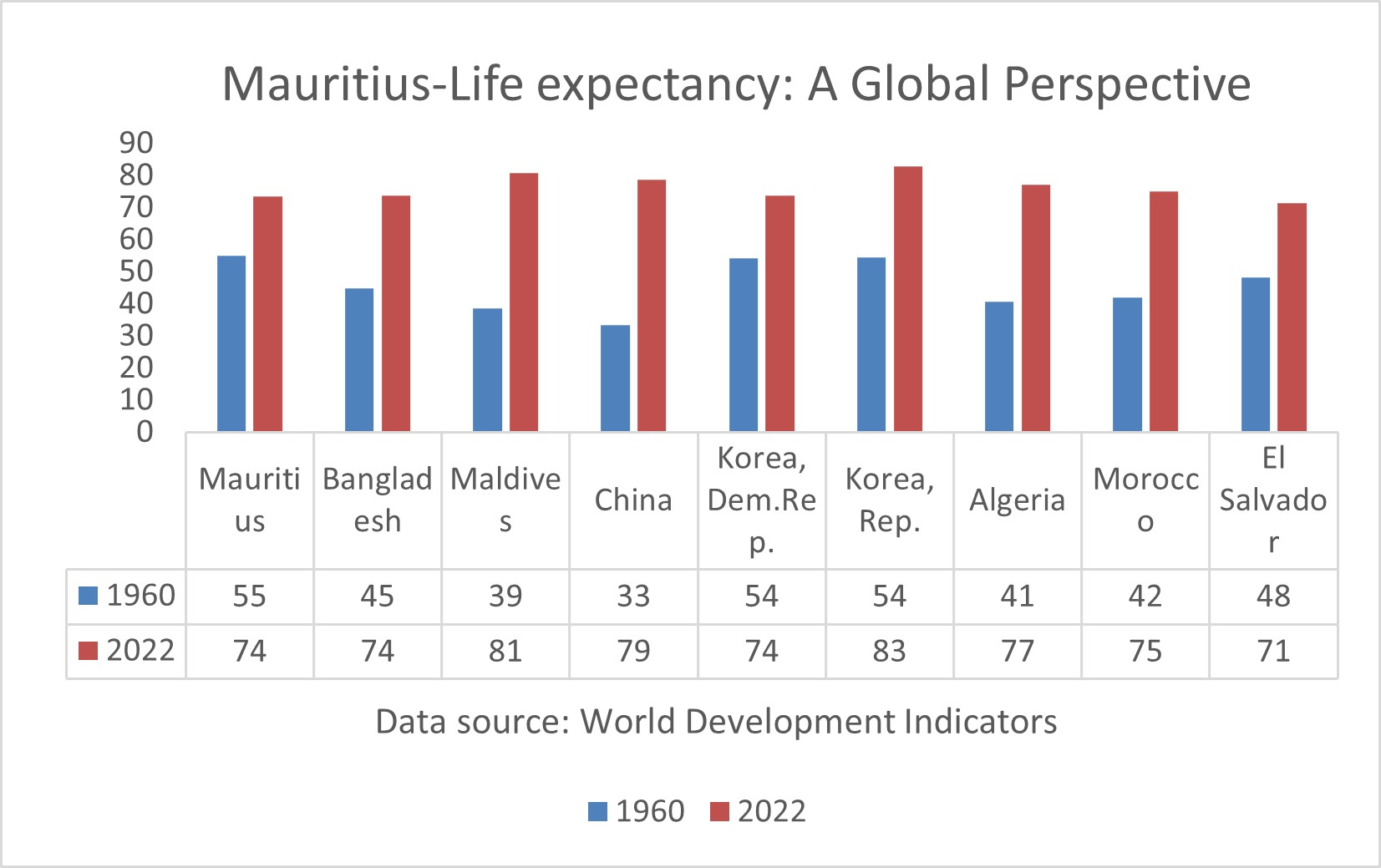
Mauritius-Mortality rate, under-5 (per 1,000 live births): A Global Perspective
Since 1950, global child mortality rates have significantly declined due to better living standards, improved healthcare access, enhanced nutrition, and safe drinking water. In wealthy countries like those in Europe and America, child mortality is now below four percent, reflecting strong healthcare systems. Over the last seventy years, many developing nations in South America, Asia, and Africa have also made notable progress. For example, Mauritius has decreased its under-five mortality rate from 40 in 1980 to 15 in 2022, and Bangladesh reduced its rate from 206 to 29, India similarly lowered its rate from 169 to 29, during the same period. These statistics reveal ongoing challenges from inadequate healthcare systems a in Sub-Saharan Africa, underscoring the vital importance of unity and collaboration and investment in sustainable health initiatives.
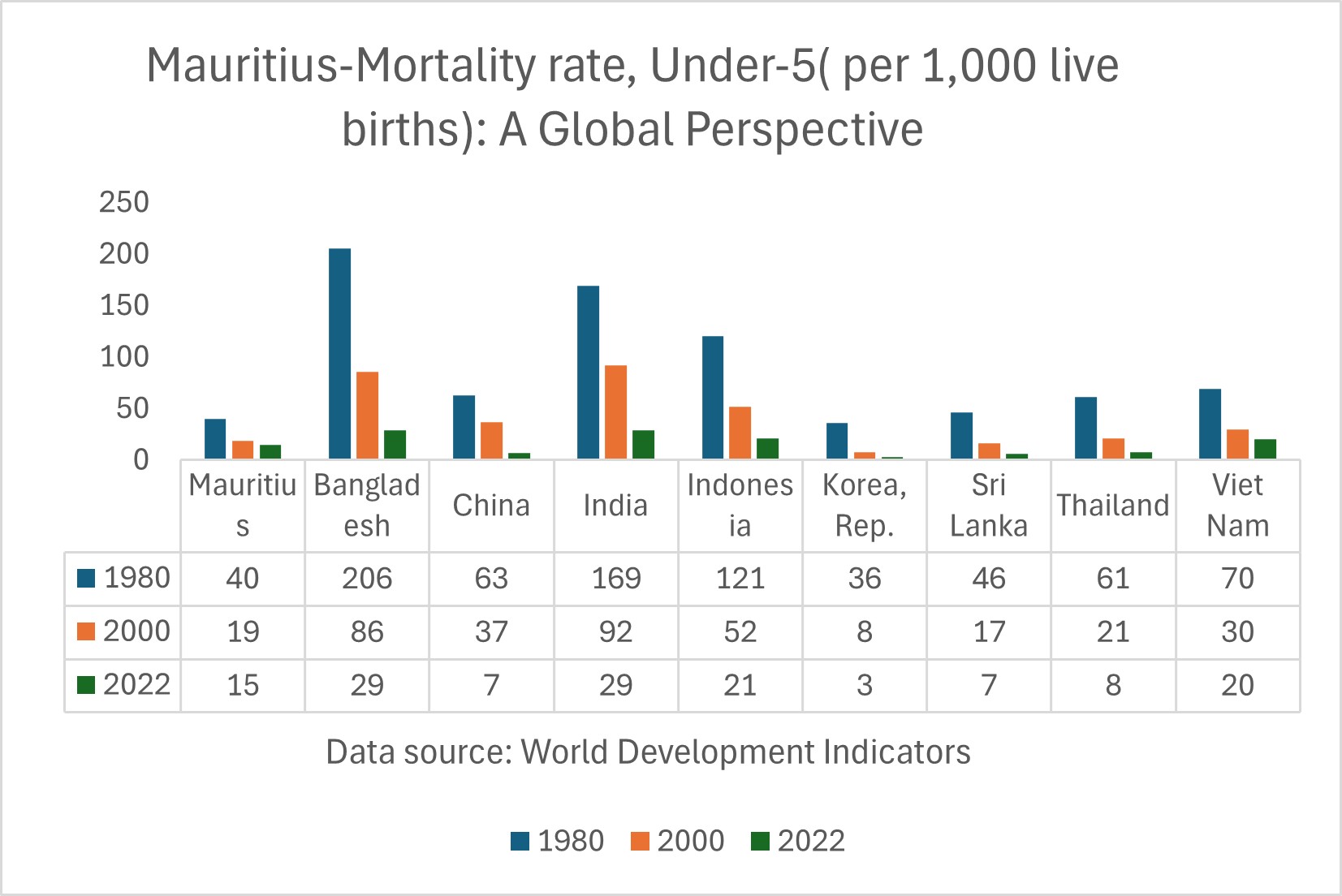
Mauritius-Maternal mortality ratio (per 100,000 live births): A Global Perspective
Mauritius has experienced a concerning increase in its maternal mortality ratio, rising from 52 in 2000 to 84 in 2020, which highlights the significant obstacles faced by women in Sub-Saharan Africa. These rates are alarmingly high compared to lower figures reported by China, Sri Lanka, and Thailand, which had maternal mortality ratios of 23, 29, and 29 respectively in 2022. Such statistics point to critical deficiencies in healthcare systems and enduring underfunding across numerous Sub-Saharan African nations. The stark disparities in maternal health outcomes in comparison to other developing regions emphasize the urgent need for unity, collaboration, and substantial investments in health infrastructure and resources to safeguard the lives and well-being of mothers and their children in Sub-Saharan Africa.
